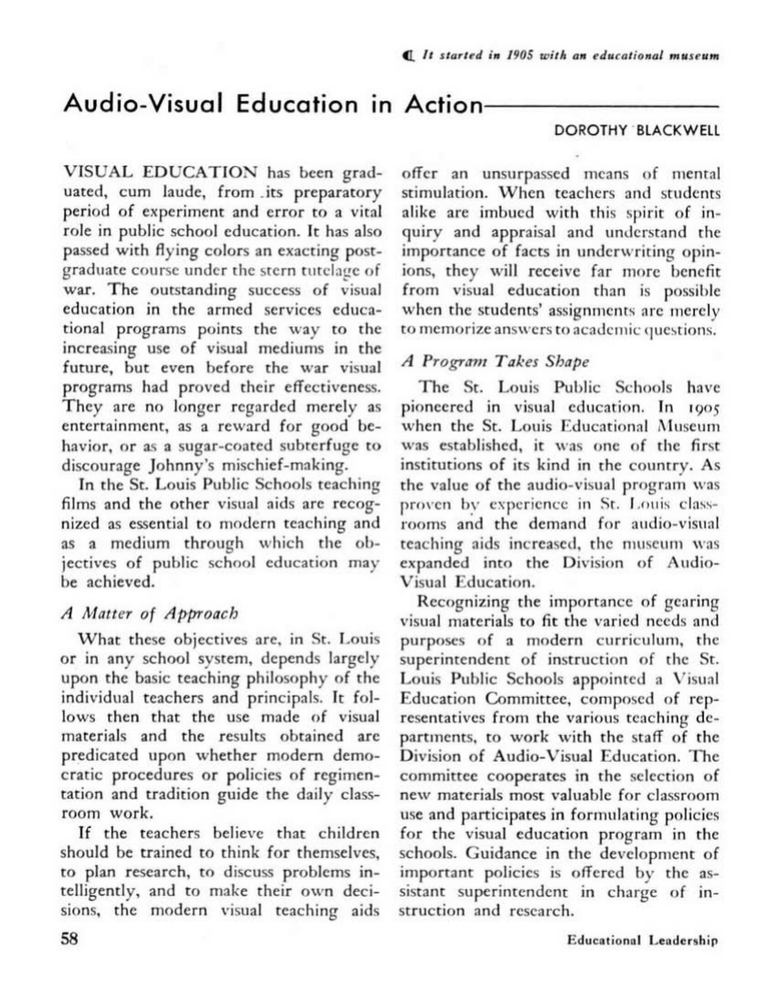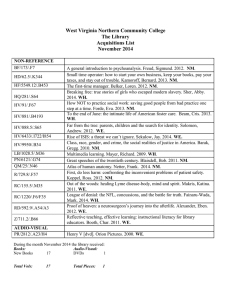
E.
It started in 1905 with an educational museum
Audio-Visual Education in Action
DOROTHY BLACKWELL
VISUAL EDUCATION has been graduated, cum laude, from .its preparatory
period of experiment and error to a vital
role in public school education. It has also
passed with flying colors an exacting postgraduate course under the stern tutclage of
war. The outstanding success of visual
education in the armed services educational programs points the way to the
increasing use of visual mediums in the
future, but even before the war visual
programs had proved their effectiveness.
They are no longer regarded merely as
entertainment, as a reward for good behavior, or as a sugar-coated subterfuge to
discourage Johnny's mischief-making.
In the St. Louis Public Schools teaching
films and the other visual aids are recognized as essential to modern teaching and
as a medium through which the objectives of public school education may
be achieved.
A Matter of Approach
What these objectives are, in St. Louis
or in any school system, depends largely
upon the basic teaching philosophy of the
individual teachers and principals. It follows then that the use made of visual
materials and the results obtained are
predicated upon whether modem democratic procedures or policies of regimentation and tradition guide the daily classroom work.
If the teachers believe that children
should be trained to think for themselves,
to plan research, to discuss problems intelligently, and to make their own decisions, the modern visual teaching aids
58
offer an unsurpassed means of mental
stimulation. When teachers and students
alike are imbued with this spirit of inquiry and appraisal and understand the
importance of facts in underwriting opinions, they will receive far more benefit
from visual education than is possible
when the students' assignments are merely
to memorize ans wers to academic questions.
A Program Takes Shape
The St. Louis Public Schools have
pioneered in visual education. In 1905
when the St. Louis Educational Museum
was established, it was one of the first
institutions of its kind in the country. As
the value of the audio-visual program was
proven by experience in St. L.ouis classrooms and the demand for audio-visual
teaching aids increased, the museum was
expanded into the Division of AudioVisual Education.
Recognizing the importance of gearing
visual materials to fit the varied needs and
purposes of a modern curriculum, the
superintendent of instruction of the St.
Louis Public Schools appointed a Visual
Education Committee, composed of representatives from the various teaching departments, to work with the staff of the
Division of Audio-Visual Education. The
committee cooperates in the selection of
new materials most valuable for classroom
use and participates in formulating policies
for the visual education program in the
schools. Guidance in the development of
important policies is offered by the assistant superintendent in charge of instruction and research.
Educational Leadership
faculty groups and individual teachers,
Learning Aids Are in the Budget
and
serve as consultants regarding the use
During the last school year the comfilhns,
film strips, and other teaching
of
mittee and the Division of Audio-Visual
The
staff specialists also work
devices.
Education made a thorough survey of the
training and studentin-service
with
and
visual
materials
system's
St. Louis
the
two teachers colleges
classes
at
teacher
projection equipment and the anticipated
schools
and aid individual
public
of
the
needs for the future. To provide for the
orderly, progressive development of the teachers who visit the Division of Audioaudio-visual program and to meet existing Visual Education for help on specific
requirements of the teachers, the com- problems.
mittee recommended the adoption by the lVhat You Need, WIhen You Need It
Board of Education of a progressive visual
Effective utilization of visual teaching
education program to be completed over
a four-year period at a cost of approxi- materials depends upon having them availmately $135,ooo. The committee also rec- able at the time they fit the interests and
ommended that the Board make specific assignments of the students. All of the
budgetary provisions for the acquisition visual materials available for classroom use
of additional visual aids and equipment. are described in a catalog compiled by the
At its July meeting the Board authorized Division of Audio-Visual Education and
the adoption of a budget covering the published by the Board of Education.
committee's recommendations for 1944-45. Every teacher in the St. Louis system has
One of the important duties of the a copy of the catalog. Orders for visual
Visual Education Committee is to co- materials are assembled in each school
operate with the staff of the Division of building by one teacher who is designated
Audio-Visual Education in the selection as the key person in the distribution of
of visual aids and in the program of class- materials in that school.
To enable the Division of Audio-Visual
room use. Teachers with special training
in visual education are assigned to the Education to make deliveries promptly,
staff to assist the director in developing the Board of Education maintains two
the effective use of visual teaching ma- delivery trucks assigned exclusively to the
terials in the schools. Upon request the Division. Deliveries are made to every
staff members visit the schools, work with school in St. Louis once each vweek. Teachers are requested to mail their orders to
the Division at least forty-eight hours in
advance of delivery. Thus a teacher, as
How a place was won for audio-visual aids in
the public schools of a large American city is
she plans her work for the next week,
described by Dorothy Blackwell, assistant in
may decide what materials will be most
the St. Louis Division of Audio-Visual Edusuitable and is not required to prepare
cation. Miss Blackwell traces the growth of
the St. Louis program from its small beginher order for visual aids weeks in advance
nings in 1905 as an educational museum to
of their use.
its present position of prestige. Recently, the
Board of Education adopted the first year's
From the inception of visual education
budget of a four-year fixmcial plan totaling
in St. Louis, it has been the policy of the
S135.000. She discusses the actual organization
of the St. Louis staff and touches briefly on
Division to provide as great a variety of
the philosophy underlyisg wise use of audio
visual materials and teaching aids as posand visual materials.
sible. As a result of this policy. rigidly
November, 1944
59
maintained throughout the years, the
Division's catalog today features such
diversified materials as foreign dolls in
costume, collections of articles illustrating
the life and customs of the American
Indians, the Chinese, and the early American settlers. Teachers have available collections of mounted birds and mammals,
insects, and reptiles. Children may study
food products, rocks, minerals, and industrial collections, and have available the
scientific apparatus for simple experiments. As far as possible all visual materials are distributed so that the children
may handle the individual objects and
study them closely for detail.
Audio and Visual Aids Combine
for Effective Teaching
Teachers are urged to correlate the use
of educational films with other audiovisual aids, including film strips, lantern
slides, photographs, booklets, charts,
framed pictures, phonograph records, and
radio transcriptions. All of these materials
are available through the Division of
Audio-Visual Education.
The Division is preparing to encourage
the use of radio programs during the coming year as another type of correlation of
visual and audio materials. The responsibility for the development of the program of radio education has been placed
in the Division of Audio-Visual Education, which is working with the Committee on Radio Education, recently
appointed by the superintendent of instruction.
Two fundamentals govern the basic
policy of audio-visual education in the
St. Louis schools. One is to make the
most effective use possible of the audiovisual teaching aids now available. The
other is to be constantly on the alert for
new materials and teaching techniques
which will help provide the understanding
necessary to solve the problems of an
everchanging, dynamic civilization.
4a Our sailors' sights are high
Training Aids Step Up Navy Instruction
A PRIME OBJECTIVE of all armed
forces training is "Maximum Learning in
Minimum Time." To attain this objective,
the services are increasingly turning to
audio-visual instructional tools commonly
called training aids.
In the Navy the aids have been written
into the various curricula, and directives
have been issued whereby training officers
and instructors must use them at the appropriate time and in ways that are based
upon proved instructional techniques.
Training aids, as defined by the armed
60
forces, include motion picture training
films, sound and silent slide films, slides,
mock-ups, models, exhibits, simulated
training devices, posters, photographs,
recordings, and radio.
Results of Use
While, to date, little detailed evidence
bearing on specific results of their use
has been released to the general public,
the comments of thousands of hardboiled Navy, Marine Corps, and Coast
Guard officers and men clearly attest their
Educational Leadership
Copyright © 1944 by the Association for Supervision and Curriculum
Development. All rights reserved.


